After a record breaking 2019 Cahow nesting season, the 2020 season is off to an early start with one of the CahowCam 1 pair having returned on the evening of October 22nd.
Watch it LIVE now on the official CahowCam Page.
Your Custom Text Here
After a record breaking 2019 Cahow nesting season, the 2020 season is off to an early start with one of the CahowCam 1 pair having returned on the evening of October 22nd.
Watch it LIVE now on the official CahowCam Page.
Cahow Class of 2019
As we ramp up for the upcoming 2019/20 Cahow breeding season here is a summary of the record breaking 2018/19 Season
Submitted by: Jeremy Madeiros, Principle Conservation Officer – Terrestrial Conservation; Dept. of Environment and Natural Resources (DENR), Bermuda
Bermuda’s National Bird, the endemic and critically endangered Cahow, or Bermuda petrel (Pterodroma cahow) has, during the latest breeding season (starting in October 2018 and ending in mid-June 2019) continued its slow, but accelerating recovery from the edge of extinction. During this season, new record high numbers were established both in the size of the breeding population, and in the number of successfully fledged chicks.
Only 17-18 breeding pairs remained in the early 1960s, when conservation and recovery management of the breeding population and potential threats began under Dr. David Wingate. By 2000, when Dr. Wingate retired and I took over the Recovery Project, the number of breeding pairs had increased to 53-55. 19 years on, I am happy to report that the number of established breeding pairs of Cahows has increased to 131.
The 2018/2019 breeding season included a number of collaborative research projects that have been undertaken by the Terrestrial Conservation Division of the DENR with international partners. In conjunction with two separate groups, a multi-year program of fitting Cahows and a few Tropicbirds with 2 different types of advanced GPS tags was initiated to accurately map oceanic foraging area use. The first of these groups, including researchers Letizia Campioni of Italy and Monica Silva of Portugal, representing MARE-IPSA and CE3C-FCUL respectively, arrived in Bermuda and spent several weeks in January and February 2019 on Nonsuch deploying 22 GPS units on the tail feathers of adult Cahows that were incubating eggs, to accurately map foraging area use during the egg incubation period, and again in March and April during the early chick provisioning period. These GPS tags record data for up to 5 weeks and do not process or calculate location in real-time; instead, the units record the time taken to contact the GPS satellites, which in turn is used to determine location every 30 minutes when downloaded. These location fixes are accurate to within a meter or two, and by not using a transmitter, the units are even lighter (and a thousand times more accurate) than the archival geolocators used a decade before, at only 3.1 grams in weight.
Almost all tags were eventually recovered from the birds, with extremely detailed location data recorded both during “off-shift” feeding trips by incubating adult Cahows (when their partners relieved them from egg incubation duties), and during provisioning trips out to sea to gather food for the growing chicks. The data showed the birds flying at speeds of up to 40-50 mph when returning to Bermuda from foraging areas, and one of the first tags recovered recorded a visit to the Georges Bank, a well-known fishing ground 120 miles southeast of Boston. The Cahow making this 800-mile trip was a male that incidentally was the first translocated bird confirmed returning back to Nonsuch in 2008!
In addition to the GPS studies, blood and feather samples were collected from nearly 90 adult Cahows, and are currently being analyzed to investigate the following:
A) To identify the trophic niche of adult Cahows during the breeding season, by Stable Isotope Analysis of the blood and feathers;
B) To investigate whether birds are exposed to Persistent Organic Pollutants integrated with diet (analyzing blood samples to determine levels of DDT, DDE, PFOs, PCPs etc.);
C) To understand whether the relatively high proportion of infertile, failed eggs is related to the concentration of bioaccumulated contaminants (e.g. DDT/DD have toxic effects causing eggshell thinning) and/or to bird breeding experience (i.e. relatively high percentage of younger, inexperienced breeding adults)
The second group consisted of Carina Gjerdrum of the Canadian department of Environment and Climate Change, and Andre’ Raine of the Kauai Endangered Seabird Recovery Project, who also visited Bermuda in April, staying on Nonsuch Island while they deployed slightly larger German-made GPS tags. These tags use small solar panels to extend battery life so that tags can collect data for much longer periods of as much as 4-6 months. They also transmit their data directly to a base station unit set up on the ground at the nesting colony site, so that the tags do not have to be physically removed from the birds to collect the data. A total of 6 tags were deployed by this team, with location data from chick feeding trips being eventually received from all of them.
An important development for the Cahow has been the establishment of new nesting colonies on two additional larger islands in Castle Harbour. When recovery efforts began in the early 1960s, the Cahow only nested on four tiny islets with a total area of just 3.401 acres (1.376 ha). An effort to establish a new nesting population on Nonsuch Island (area 16.5 acres / 6.677 ha) began in 2004 with two separate translocation programs, with 102 chicks translocated to Nonsuch 2004-2008, and 65 chicks translocated 2013-2017. These projects have been successful, and there are now two breeding colony sites on Nonsuch, supporting a combined total of 22 established breeding pairs in 2019.
Including Southampton Island, in which natural colonization was confirmed in 2013 and on which a small but growing population of Cahows also nest, the total breeding habitat has increased from 4 islets totaling 3.4 acres, to 6 islands totaling 22.261 acres.
The new Nonsuch Island colonies are especially important for the future recovery of the Cahow, as they could potentially support several thousand nesting pairs. The original nucleus of pairs consisting solely of translocated Cahows at the Nonsuch sites are now increasingly being supplemented by non-translocated prospecting birds attracted from the original nesting islets, and of chicks produced by the new Nonsuch breeding pairs, of which at least 7 have now returned to Nonsuch Island to choose nest burrows and mates. An indication of the success and productivity of the new Nonsuch population is the fact that since the first Nonsuch-born chick, named “Somers” was produced in 2009 by a translocated pair of Cahows, by 2019 a total of 79 successfully fledging chicks have now been produced by the growing Nonsuch population.
Despite lower than-average weights recorded for a number of the chicks this season, indicating that food was more difficult for the adults to find at their foraging areas, a record number of 73 successfully fledged chicks was recorded for 2019, of which 12 were produced by the Nonsuch colonies. Low weights resulted in a total of 8 chicks having to be taken into care and given supplemental feeding of fresh Anchovies, and I am happy to report that 7 of the 8 chicks recovered enough weight to fledge successfully out to sea.
Public outreach efforts using live-streaming infrared video cameras continue to evolve, with two new livestream camera options developed and installed by JP Rouja of LookBermuda / The Nonsuch Expeditions and the Cornell Lab Bird Cams in partnership with the DENR. A new live-cam was installed in a 2nd Cahow burrow, and a new “Surface Cam” provides a view out over the front of the nesting colony and the south coast of Nonsuch Island. This proved timely, as the egg failed in the original “CahowCam 1” nest, but the 2nd camera provided an alternative as the chick hatched and eventually fledged to sea in early June, sharing the nest for a month with a Leaches Storm-petrel! This was likely the same bird seen in the other CahowCam nest on two previous years after the Cahow chicks had fledged. This tool has proved invaluable not only to our Team but also for our public outreach through which researchers, students and followers from around the World have watched over 20 million minutes of CahowCam video over the past 3 seasons!
Preparations are now underway for the return of the Cahows in late October for the 2019-2020 nesting season, and although Bermuda was severely affected by hurricane “Humberto” on the 18th September, with considerable roof, tree and utilities damage throughout Bermuda in winds gusting to 117-126mph, Nonsuch and the smaller Cahow nesting islands suffered very little damage. Because of the approach of the hurricane from the west-southwest, there was almost no storm surge or damaging ground swell damage to the Castle Harbour Islands, and all of the concrete nest lids remained in place on the smaller nesting islets.
This past hurricane season our followers around the World used our LiveCams to monitor the storms from our view of the South Coast of Nonsuch Island.
During Humberto, despite 80% of the Bermuda mainland loosing power, we were able to remain LIVE using the Solar Array on Nonsuch, our wireless internet connection, and a stronger than expected post that held our new surface camera during the 100 mph+ winds
Hurricane Humberto passed by Bermuda on September 18th / 19th 2019 where its stronger than expected winds created more damage than expected to the island’s foliage and power grid leaving 80% of the island in blackout after it passed. There was also damage to homes and other structures throughout the island, however due to our concrete construction methods and slate stone roofs it was nowhere near the amount of damage that would be expected should the same 145 mph winds have passed through the Caribbean. On the whole our infrastructure remains intact and as of Tuesday the 24th the vast majority of homes have power back and the island definitely open for business from a Tourism point of view.
Nonsuch Island held up quite well, our solar array is intact and working, our wireless internet link to the mainland is still live and we were able to live stream from our new surface camera in Translocation Colony A throughout the storm which was viewed from this page and published to Facebook LIVE for viewers around the World.
See Jeremy’s preparation video here and a replay of the FaceBook stream below.
Nonsuch Expeditions Team Leader J-P Rouja and Youth Explorer Sophie Rouja took the Greenpeace Esperanza and Greenpeace España crews on a Nonsuch Expedition to visit the Nonsuch Island nature reserve. They had just finished several Expeditions into the Sargasso Sea and the waters surrounding Bermuda where they were able to document ocean-plastics and micro-plastics in amounts comparable to the Pacific Garbage Patch. J-P had joined the final expedition as photopgrapher, and invited them to Nonsuch to see the plastic collection from the soon-to-be-announced Nonsuch Plastics Project. #ProtectTheOceans
For the second time in 3 years, Stormy defends the now empty CahowCam 2 burrow from an invading Land Crab.
In a rematch from his first battle in 2017 “Stormy” a very lost, lonely Storm Petrel promptly evicted the Land Crab which was most likely scavenging for food in what it expected to be an empty burrow.
Historically as has now been proven by the Live Streaming CahowCams, Land Crabs will wait until the chicks have fledged and the nest is empty before coming in to scavenge for anything edible, including left over food, failed eggs and detritus, effectively cleaning out the burrow.
Stormy also used to wait for the nest to be empty before moving in, however this year much to the confusion of the Cahow pair, their extremely patient chick and 10’s of thousands of viewers from around the World he showed up several weeks early and refused to leave.
The chick fledged several weeks ago and he is now back to nest building and calling out all night long to attract a mate.
Good Luck Stormy!
Bermuda seems to be a favorite destination for lost and vagrant seabirds, which is not surprising when you consider its solitary location as the only oceanic island in the Northwest Atlantic between the Caribbean and Nova Scotia. The nearest landmass is Cape Hatteras in North Carolina, located almost 600 miles to the west-northwest. Recently, Roseate Terns have started to re-nest on Bermuda for the first time since the 1830s, and we have been watching with interest for several years the attempts of “Stormy”, a Leaches Storm-petrel, to attract a mate to at least 2 separate nest burrows at the recently re-established Cahow nesting colony on the Nonsuch Island Nature Reserve. This is despite the fact that the nearest nesting colonies of Leaches Storm-petrel are 800 miles away on islands off the coasts of Maine and Nova Scotia.
An even more improbable record has now occurred, with a dark-morph Trindade Petrel (Pterodroma arminjoniana), which is in the same genus as Bermuda’s own endemic Bermuda Petrel or Cahow (Pterodroma cahow) was found on the ground by Mr. Robert Cabral in a Nature Reserve area on the South Shore of Bermuda. This bird looks very similar to our Cahow, except it is all dark grey, with a larger wingspan. It occurs in both a light morph, with much lighter plumage in the belly and wings, and the dark morph. It appeared to be prospecting for a nest site under some hurricane-deposited boulders, only a few feet from a heavily used public trail, and called loudly when approached.
This trail is heavily used by the public for walking their dogs, which are often illegally let off their leashes, and there are a number of feral cats wandering in the Reserve, associated with a nearby cat feeding station. These cats have been photographed in this Reserve several times killing water birds as large as Coots and Moorhens (Gallinules), and so pose a serious threat to any ground-nesting seabirds, and to top it off there is a large population of rats living in the area.
Unlike Nonsuch Island and other offshore islands, from which mammal predators can be more easily eradicated or kept off, introduced mammal predators cannot be completely eliminated from sites on the main island of Bermuda. This situation is compounded by regular “dumping” of unwanted cats from other locations on the island, and the presence of feral cat feeding stations by well-meaning but misguided members of the public, despite the fact that these are illegal in National Parks and Nature Reserves on Bermuda.
Due to these factors, it was felt that its presence in a easily accessible ground nest placed this bird in imminent danger of predation (unlike White-tailed Tropicbirds, which nest near this area in cavities in vertical coastal cliffs not usually accessible by Cats and Dogs), and the decision was made to remove the bird and take it to the Bermuda Aquarium, Museum and Zoo.
After a brief examination and morphometric measurements by Mr. Paul Watson and myself, the bird was fitted with an identification ring (band), which will enable the bird to be positively identified should it be recaptured anywhere. The bird was found to be in good physical condition and at a good weight, and based of the feather moult sequence and the amount of filoplumes (small, hair-like structures) on the bird’s head, Mr. Watson felt that this was a relatively young bird, perhaps prospecting for a potential nest for the first time.
The decision was made to take the bird out to Nonsuch Island, where all mammal predators have been removed and where there are two breeding colonies of the related Bermuda petrel, since I felt that it best for the bird to recover in and perhaps acclimatize to a new, safer and more suitable potential nesting area. The Trindade petrel was placed into the failed “CahowCam 1” nest burrow, where the resident Cahows had departed since early April after the failure of their egg, but which still contained nest material and the distinctive musky “petrel” smell. The burrow entrance was blocked for 24 hours to enable the bird to fully recover, during which time it could be monitored with the livestream camera and its reactions noted, and it was unblocked the following day at about 3pm.
Much to my surprise, the petrel appeared to settle down immediately inside the burrow and preened itself, gave an occasional loud cry of the type that is uttered inside a nest burrow to attract mates, and created a nest scrape and re-arranged nest material. After I unblocked the entrance of the burrow the next day, the bird did not try to leave immediately as thought and stayed for the next 24 hours, continuing to act as though it was settling down inside the burrow and staying firmly inside.
It was not until Saturday afternoon, after two full days in the burrow, that the Trindade Petrel left the nest chamber after a last look back and leaving excreta to “mark” the burrow, and walked outside, where it spent several minutes looking around and getting its bearings. Finally, after spreading its wings a few times on top of the entrance to the adjacent “CahowCam 2” R832 nest burrow, the bird took off strongly straight out to sea, departing at 3.23 pm. This is in marked contrast to the cahow, which never leave their nest burrows during the light of day, being completely nocturnal on the breeding grounds. My impression was that the bird behaved similarly to how Cahow fledglings do when they imprint at night before departing to the open ocean.
What makes this all even more interesting is that this is now the third time a Trindade Petrel has been recorded near, over or on Bermuda in the last few years; a light-morph Trindade was seen several miles off the east end of Bermuda flying with Cahows by a pelagic birding group in November 2016; and only in January and February of 2019, another light-morph bird was seen flying & calling repeatedly over a residence in central Devonshire Parish, near the center of the main island of Bermuda, returning repeatedly during the afternoon over several weeks.
The Trindade Petrel only nests in the Southern Hemisphere on Trindade Island and the Martin Vaz Islands in the South Atlantic Ocean, about 1,100 kilometers (680 miles) east of the coast of Brazil, which it constitutes a part of. Trindade has a total area of 10.1 square kilometers (3.9 square miles), while the tiny Martin Vaz islets have an area of only 0.3 Square kilometers (30.0 hectares). The islands are volcanic in origin, and have rocky, mountainous terrain. The population is only 32 Brazilian Navy personnel at a Coast Guard and Research station. 85% of the island was formally covered with forest until goats were released in 1700 by Sir Edmund Halley from HMS Paramore. Other invasive alien mammals were also introduced at different times, including pigs, cats and mice, which collectively had a catastrophic effect on the island’s flora and fauna, much of which was unique to the island.
The Goats in particular massively increased in number and destroyed the forest cover, eating all foliage and stripping the bark off vegetation. The island’s trees were almost entirely eliminated, causing massive erosion of soil. Things are looking much more hopeful for the island at the present time, with pigs being eradicated from Trindade by the 1950s, the last goats by 2005, and cats by 2009. Efforts are still underway to remove the last mice, and these measures are beginning to enable restoration of the island, enabling the remaining native flora & fauna, including the Trindade Petrel, to be preserved, and enabling areas which still have some soil cover to be reforested.
It is probable that these invasive mammals have had a serious impact on the Trindade Petrel population and other seabirds nesting there, as they have on many other oceanic islands, including Bermuda. Following extensive research, the estimated population of Trindade Petrel was recently revised to 1,130 breeding pairs (compared to a total population of 131 pairs of Cahows on Bermuda). There are also several hundred pairs of Trindade Petrel nesting on Round Island in the Indian Ocean, near Mauritius.
We have no idea what the ultimate outcome of this extraordinary record will be or why these birds seem to be taking an interest in Bermuda, which is over 5,000 miles from its breeding colony, which even lies in a different hemisphere. Natural History is rarely dull, but this record is definitely one for the history books, and we will wait with great interest to see if this bird returns to possibly try and establish a foothold for the species on Bermuda, or if it is indeed a once-in a lifetime record.
Jeremy Madeiros | Principle Scientist – Terrestrial Conservation, Dept. of Environment and Natural Resources, Bermuda
Watch a LIVE view of the CahowCam 1 burrow to see if it returns.
The 2019 Nonsuch Expeditions “Longtail-Cam” White-tailed Tropicbird chick, fledged and departed out to sea at 8.29am on Monday, the 1st of July, 2019.
“Pig-Pens” parents returned unusually early to Bermuda for this year’s breeding season, first being seen in the beginning of February in the artificial “Igloo” nest # 387 that is installed along the stairway running up from the main dock on Nonsuch Island Nature Reserve where the latest Nonsuch Expeditions Tropicbird Cam was installed this Season.
This nest was installed by a school group as a class project during 2006, and was colonized by a pair of Tropicbirds (Longtails) during the same summer. It produced its first successfully fledging chick in the summer of 2007 since which it has had a very successful record of breeding success, producing successfully fledging chicks in 10 of the last 12 years, with failed breeding only in 2009 and 2016.
This nest, along with over 80 others on Nonsuch Island and a total of nearly 300 nests, at ten study locations around Bermuda, have been monitored and their breeding success recorded every year since 2006 by the Senior Terrestrial Conservation Officer as part of a long-term study of Tropicbird breeding biology and population dynamics on Bermuda.
Over 1500 Tropicbirds have been fitted with identification bands as part of this study, including all 10 chicks that have so far fledged from “Pig-Pens” nest.
For the 2019 breeding season, the adult Tropicbirds from nest # 387 laid their single egg around the 6th of March, one of the earliest records of Tropicbird egg-laying that has been recorded during the study. This egg was incubated by both parents for 48 days, with the chick hatching on Tuesday the 23rd of April. The chick grew rapidly, increasing from 45 grams in weight on the 26th of April, when the first growth check was carried out on the 3-day old chick, to its maximum recorded weight of 560 grams on the 12th of June, when it was fitted with i.d. band no. C1521. This band will enable positive identification for the rest of its breeding lifespan.
“Pig-Pen” was given its last growth check on the 29th of June, 2019, by which time its weight had dropped to 427 grams, and wing chord (outer wing) length had increased to 259 mm. Our Tropicbird chick fledged out to sea 69 days after hatching on the first day of July, 2019, and likely will not return back to the Castle Harbour Islands on Bermuda for several years. Recaptures of Tropicbirds banded as chicks indicate that they first return to choose nest sites and mates at 3 to 4 years of age, and that they generally return if not to the same nesting island, then to one in close proximity. The bill length of “Pig-Pen” seems to indicate that it is a male bird, so we will be looking out for its return to Nonsuch or a neighboring island around 2022-2023.
Jeremy Madeiros | Senior Terrestrial Conservation Officer, Bermuda Dept. of Environment & Natural Resources
For the third year in a row, a very lost and lonely Storm-petrel has been building a nest and trying to attract a mate to the Cahow Colony on Nonsuch Island.
As far as we know, this is the first time a Storm-petrel has attempted this, as although they are found offshore of the island in deeper waters, they have never been known to nest or even land on Bermuda, with their closest nesting colonies being 800 miles away on islands off the coast of Maine and Nova Scotia.
The last 2 seasons he was filmed arriving into the recently vacated CahowCam burrow a few days after the resident Cahow chick had fledged and would spend the next few weeks building a nest and calling out at night for a mate, ultimately in vain.
This year however, he arrived 2 months early and moved into the still occupied CahowCam 2 burrow which he decided to cohabitate with a very patient Cahow chick.
Much to the bewilderment of scientists and the worldwide CahowCam followers, he turned his amorous attentions to the Cahow chick despite it eventually growing to almost 10 times his weight. However the adult Cahows, when encountering the Storm-petrel in the nest during their feeding visits, did not seem to consider him as a threat to their chick and tolerated his presence.
The Nonsuch Team kept a close eye on this to be sure that the Cahow chick that was doing its best to ignore him wasn’t being negatively affected and even tried re-homing him to an empty Cahow burrow after he was caught and banded, as seen in the following video.
Despite this attempt he returned to the CahowCam 2 burrow the following night where he remained through to the Cahow chick fledging a few weeks ago.
J-P Rouja | Nonsuch Expeditions Team Leader: “There was even some talk amongst our followers to start a Go Fund Me Campaign to buy Stormy a plane ticket back to where he should be nesting. But as Jeremy pointed out, even if it had been logistically possible, the most that it would probably prove would be how fast he could actually fly back here once released.”
Ultimately his rather annoying persistence did not seem to affect the chick which put on weight faster and grew larger than most others in the colony, though this may have been in part due to the parents more frequent visits to keep an eye on Stormy.
Now back on his own, he has reverted to his old routine of nest building and calling our for a mate of his own and viewers who log on to the CahowCam around 1 AM (or scroll back in the video timeline in the AM) can watch him LIVE.
Whilst an over abundance of Sargassum reaching the coastline can be seen as a nuisance and even a problem, its importance as a nursery in the open ocean can not be understated.
Beyond the numerous unique species that make it their home, including Crabs, Shrimp, Nudibranchs and the diminutive yet almighty Sargasso Fish, many larger pelagic species rely on it to carry their eggs and/or protect their young including Flying Fish and Mahi-mahi a juvenile of which can be seen here:
The fauna that the mattes contain then also serves as a very important source of food for these and other pelagic species.
Jean-Pierre Rouja | Nonsuch Expeditions Team Leader, Photographer & Sargasso Sea Commission Ambassador:
“The waves of Sargassum that reached Bermuda in April were full of this fauna early in their life-cycles as documented in this series of photos.
The photo above has a gravid Sargassum Swimming Crab (of which there were numerous in those collection efforts led by Chris Flook) holding her eggs, along with strands of Flying Fish eggs that had been wrapped around the Sargasso weed (Sargassum natans) and were just about to hatch.
In this next photo a juvenile Sargassum Fish (Histrio histrio) can also be seen which whilst I was shooting was ingesting the flying fish as soon as they hatched.
At this time of year we routinely find very small Sargassum fish, often at a rate of 1 per clump of weed, however rarely do we find more than 1 per clump as invariably they will eat each other until only 1 is left…”
Cedar stretching her wings 20 minutes before departure.
1:32 am June 7th 2019, our star CahowCam chick fledged out to sea with followers around the world watching in realtime. If all goes well she will return in 3 to 5 years, often times landing within yards of her original nesting burrow.
She is one of five that have fledged thus far this season from Nonsuch Colony A, with another 8 or 9 remaining. This rate is similar to the rest of the Colony where about a third have fledged, keeping us on track to a projected record number of 73 chicks that may fledge this year!
Jeremy Madeiros | Senior Terrestrial Conservation Officer, The Department of the Environment and Natural Resources:
“We are relieved to be able to see her fledge which is a satisfying conclusion to the 7 month process which started when her parents returned to Nonsuch to nest build and court last November. Whilst Cedar may have fledged, our work is not over, as there are at least two chicks that needed to be rescued due to insufficient feeding by their parents and the remainder of the chicks throughout the Colony which need to be monitored and managed until they fledge, not to mention all of the Tropicbird chicks, that have been hatching early this year… “
Deputy Premier and Minister of Home Affairs, the Hon. Walter H. Roban:
"Following World Environment Day and in advance of World Ocean Day, I find the progress made by the Nonsuch Expeditions in collaboration with our Department of the Environment and Natural Resources Team very encouraging. As you know, our Bermuda environment is very important to me, and the preservation and protection of our island and its indigenous species remains a top priority for the Ministry of Home Affairs. We should be very proud of the efforts that have brought our cahows back from near extinction and the efforts to share this project with the World."
Jean-Pierre Rouja | Nonsuch Expeditions Team Leader:
“The LIVE viewing of last nights activities was made possible by the installation of a brand new “Above Ground” infrared capable PTZ Camera that we have just launched in conjunction with the DENR and the Cornell Lab Of Ornithology Bird Cam Team. This is now our 4th Cam, adding to CahowCams 1&2 and a new “Longtail” TropicbirdCam which is proving to be very popular.
This is a perfect example of adapting and developing technology to assist with Conservation and Educational Outreach.”
Please keep watching the LIVE CahowCam to see how Stormy, Cedar’s ever persistent roommate reacts to her departure.
Jean-Pierre Rouja | Nonsuch Expeditions Team Leader “As part of our efforts to produce Media and develop Technology for Conservation, we have partnered with Holographic Video producers Looking Glass Factory to help develop and test their prototype cameras in Bermuda with a goal of, for the first time ever, Livestreaming Holographic wildlife footage to the World!”
Alex Hornstein | Looking Glass Factory: “I first met JP Rouja, a Conservationist, Filmmaker and Tech Developer who runs the Nonsuch Expeditions, an organization that works to document and spread awareness of Bermuda’s unique biodiversity including the Cahows, at a show last year where I was showing off an underwater holographic camera that I had built, and was using to film large underwater animals. I’m one of the co-founders of a holographic display company called Looking Glass, and for the past nine months, I’ve been working on a number of techniques to capture digital holographic images and video of the natural world, that we can play back in our displays. Holograms present the illusion that something is there in front of you when in fact it’s not — it could be a recording, or a live scene being streamed from another part of the world. Over several months, JP and I worked out a plan to stream holographic footage of Cahows from their natural habitat on Nonsuch out into the world, where they could be viewed, life-sized, in our displays…” Read full Article on Medium…
“Cedar” the 2019 CahowCam Chick exercising, June 3rd 2019
On World Environment Day a 4th LIVE Cam has been launched on Nonsuch Island as a partnership between the Nonsuch Expeditions, the Cornell Lab of Ornithology and the Department of the Environment and Natural Resources.
This new camera is located in Nonsuch Translocation Colony A, and unlike the existing nest Cams is above ground giving a view of the Island and coastline during the day and an infrared view of the Colony at night allowing scientists, students and followers from around the world to observe the Cahow chicks as they explore, exercise and imprint on their surroundings in the few nights before they fledge out to sea.
If activity in the LIVE video below has ended, you may scroll back up to 12 hours in the Timeline…
Charles Eldermire | Cornell Lab of Ornithology:
“Watching the Cahow nestling navigate the darkness and stretch its wings on the new cam shows a whole new side to Cedar, one that reinforces how close she is to heading out to sea! Plus, the daytime views of Nonsuch Island are spectacular and I can imagine lots of viewers tuning in just to bask in the beauty and to watch the longtails fly past on the wind.”
Jeremy Madeiros | Senior Terrestrial Conservation Officer, The Department of the Environment and Natural Resources:
“I project that Cedar, based on her weight and wing length from her most recent health check will fledge out to sea somewhere between the 4th and 8th of June, so the launch of this new Cam allowing us to witness this process is quite timely. When watching at night you will see her exercising and flapping her wings, however there are no test flights, so the first time she actually flies she will head out to sea, not to return, if all goes well, for 3 to 5 years...”
Jean-Pierre Rouja | Nonsuch Expeditions Team Leader:
“This new camera follows our original CahowCam that we first launched 8 years ago in Cahow burrow #831. Unfortunately the egg in this nest failed this year, however this gave the parents a much needed break as they had successfully raised a chick for the past 5 years, well above the average Cahow nesting success rate.
CahowCam 2 was launched this Spring in burrow #832, in which viewers have been following the Cahow chick, recently named “Cedar” and an increasingly persistent, annoying and never before documented Storm Petrel nest-mate.
We have also recently launched a “Longtail” TropicbirdCam in which the chick hatched a month earlier than expected and is doing very well.”
The LIVE feeds and archival recordings from the Cams have resulted in over 20 million minutes of video being watched over the past 3 seasons which will only increase over the next few years with all of these new viewing options…
The Cahows are nocturnal when approaching land and nesting, therefore the majority of activity occurs at night, usually starting around 1am, however viewers of the LIVE video feeds can scroll back as far back as 12 hours in the timeline allowing them to observe all of the prior nights nocturnal activities when checking in the morning.
J-P Rouja:
“We also have a number of Cornell volunteers and other followers across a multitude of timezones ensuring that the live feeds are always monitored in realtime and that post regular updates to our Twitter feeds. The crowd sourcing of citizen scientists to monitor 24/7 live feeds is relatively new but much welcomed phenomenon and has already helped our Team identify significant activities that we would otherwise have missed.”
Watch LIVE now:
http://www.nonsuchisland.com/live-cahow-cam
http://www.nonsuchisland.com/live-tropicbird-cam
Bermuda Petrel Biomonitoring 2019
“The 2019 Cahow breeding season has been extremely eventful, and has included two separate projects involving fitting adult Cahows with advanced GPS tags to monitor their movements at sea.
The Bermuda petrel biomonitoring project is being carried out by researchers Letizia Campioni of MARE and Monica Silva of cE3c, in partnership with the Dept. of Environment and Natural Resources and the Nonsuch Expeditions. The GPS tags were deployed during the egg incubation period in January/February, and again during the chick rearing period in March/April.
Monica and Letizia have already recovered many of these tags, with the first GPS tag with track data during chick-rearing recovered on the 4thApril.
This tag was deployed on a male Cahow (band number E0171) from nest # R836 on Nonsuch Island. This particular bird is a rather special one for several reasons. I monitored him as he hatched on 6th March 2005 in the Green Island # 4 nest, and translocated him to nest no. R833 on Nonsuch Island on 27th May 2005, as part of the project to re-establish nesting Cahows on Nonsuch, where they had not nested since the 1620s. Not only was I able to watch this bird fledge successfully to sea on the night on June 6th, 2005, but it was also one of the first translocated Cahows to return to Nonsuch as an adult, three years later in 2008. It was in fact the first translocated Cahow to stay for the day in a nest burrow on Nonsuch on 19th March, 2008.
By 2011, this bird had settled in the R836 nest, and attracted a new mate (a non-translocated female fitted with band number E0401). This pair has remained together ever since, and has raised 8 chicks in 8 straight years – clearly, he is doing an awesome job as a parent!
The data from the recovered tag revealed that he flew approx. 1200 Km (700 miles) north to feed over the North American continental shelf, in the highly productive waters of Georges Bank, in the Gulf of Maine. It took him 7 days to fly to this area, gather food, and return to feed the chick. During the outbound journey, he was travelling at a speed of approx. 35Km/h, which doubled during the return trip to 70 Km/h (about 44 mph). This is typical of the multi-thousand-mile weekly feeding trips that the adults carry out over a 3-month period to provision the growing chick. A number of additional tags have been recovered since then and are starting to give a very detailed picture of Cahow foraging areas and movements at sea during their breeding season.”
Jeremy Madeiros, Senior Terrestrial Conservation Officer, Dept. of Environment and Natural Resources, BERMUDA
The results of this and future tracking exercises will be incorporated into the curriculum that we are developing. Educators should contact us or sign up to our Newsletter selecting the educator option.
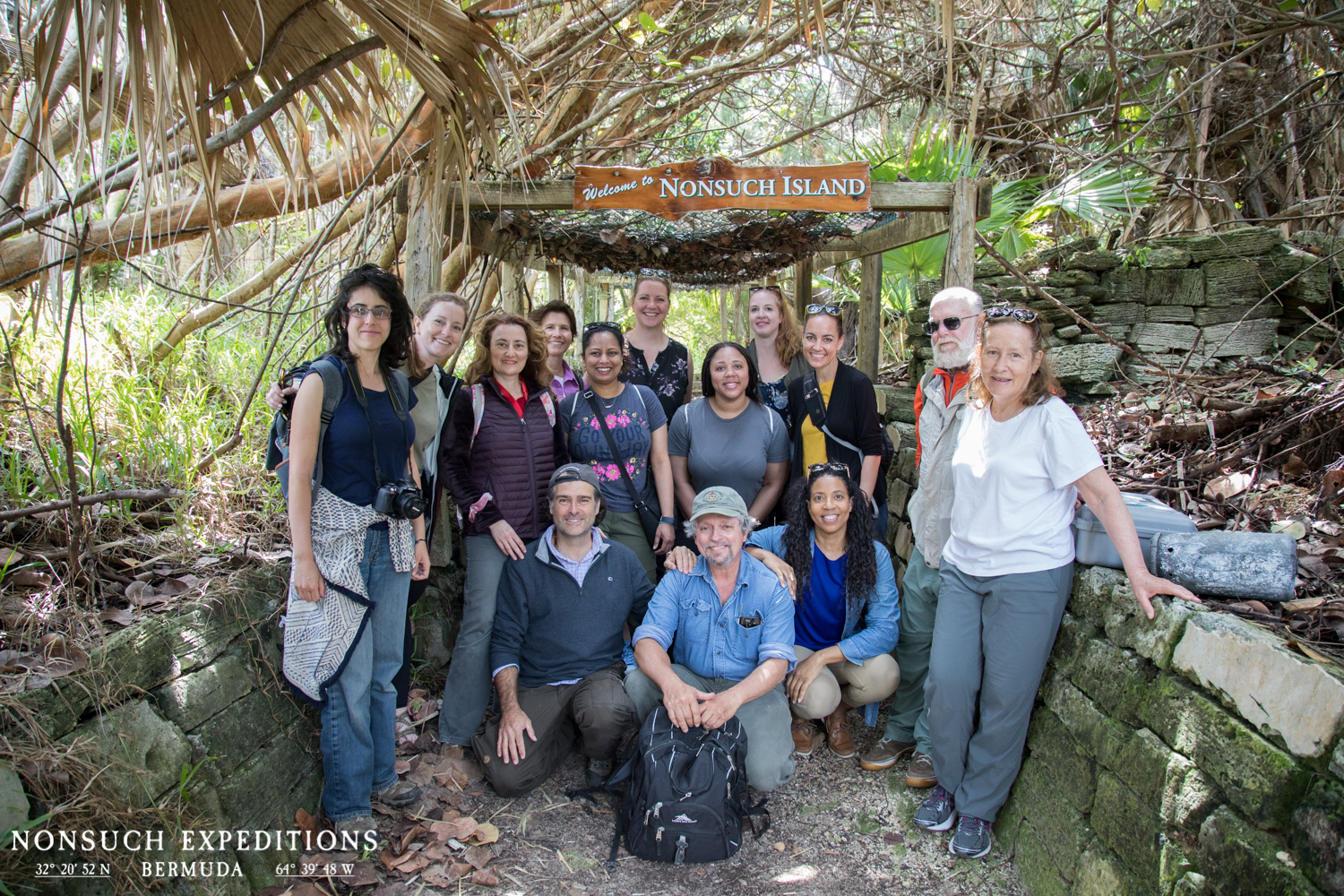
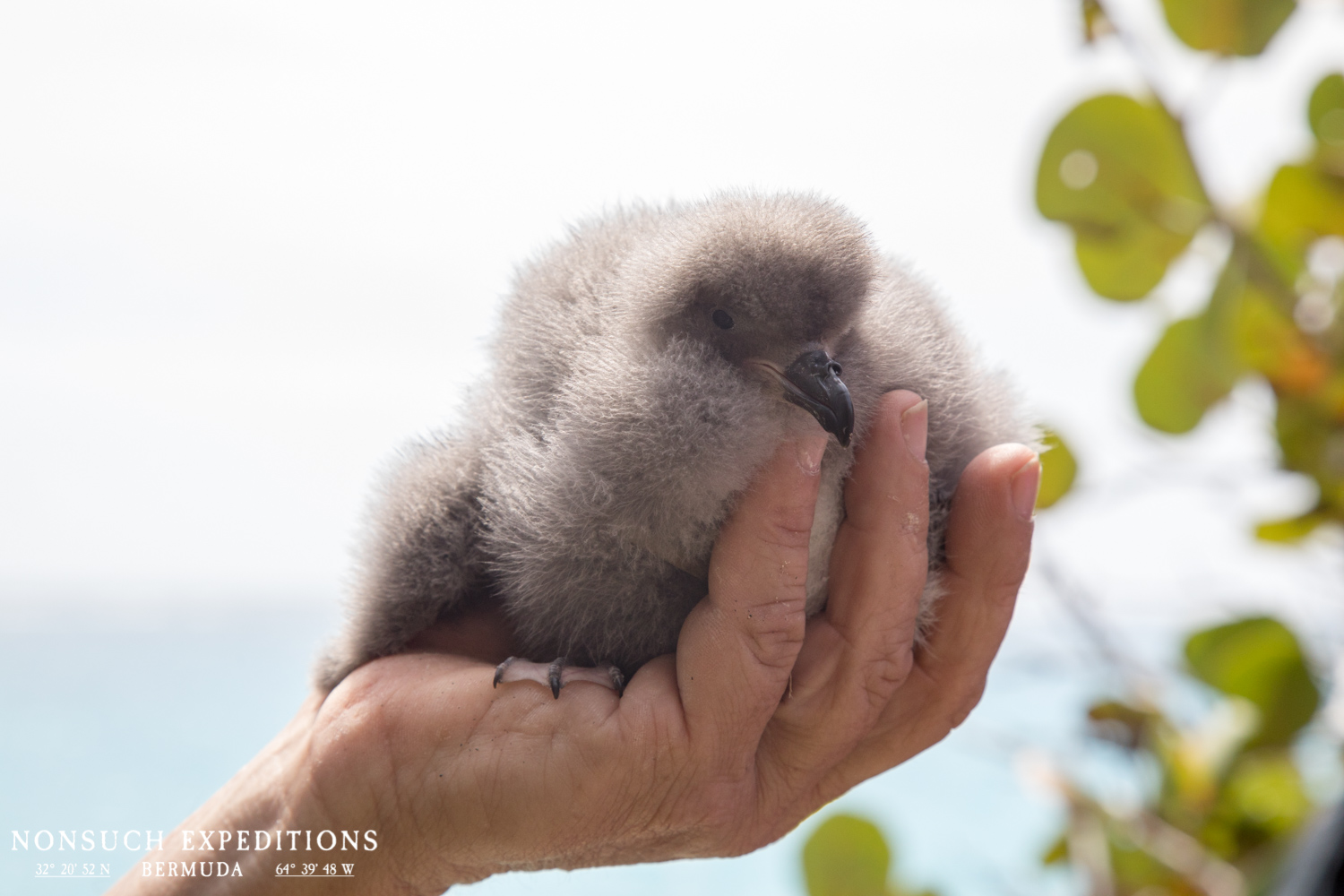
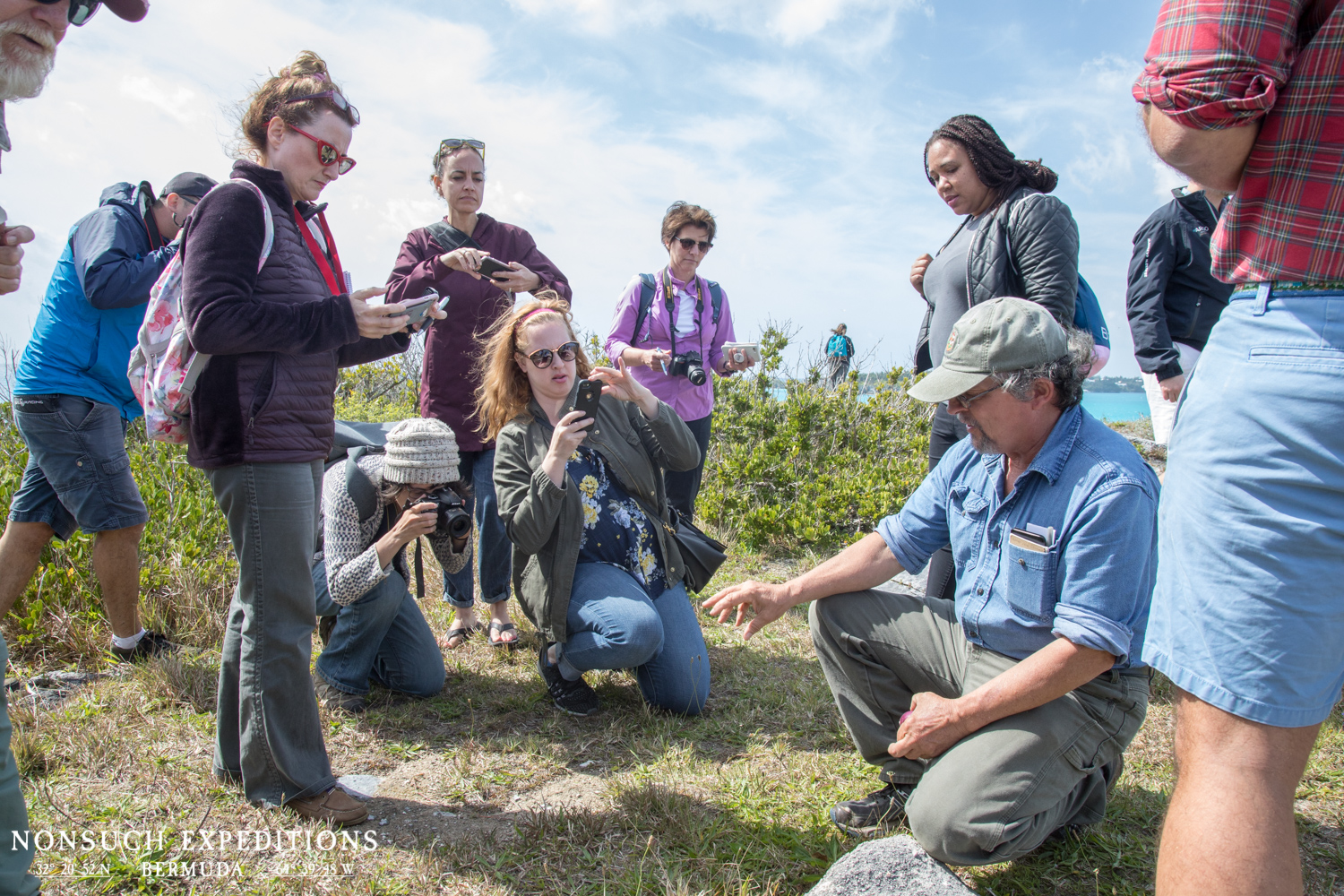

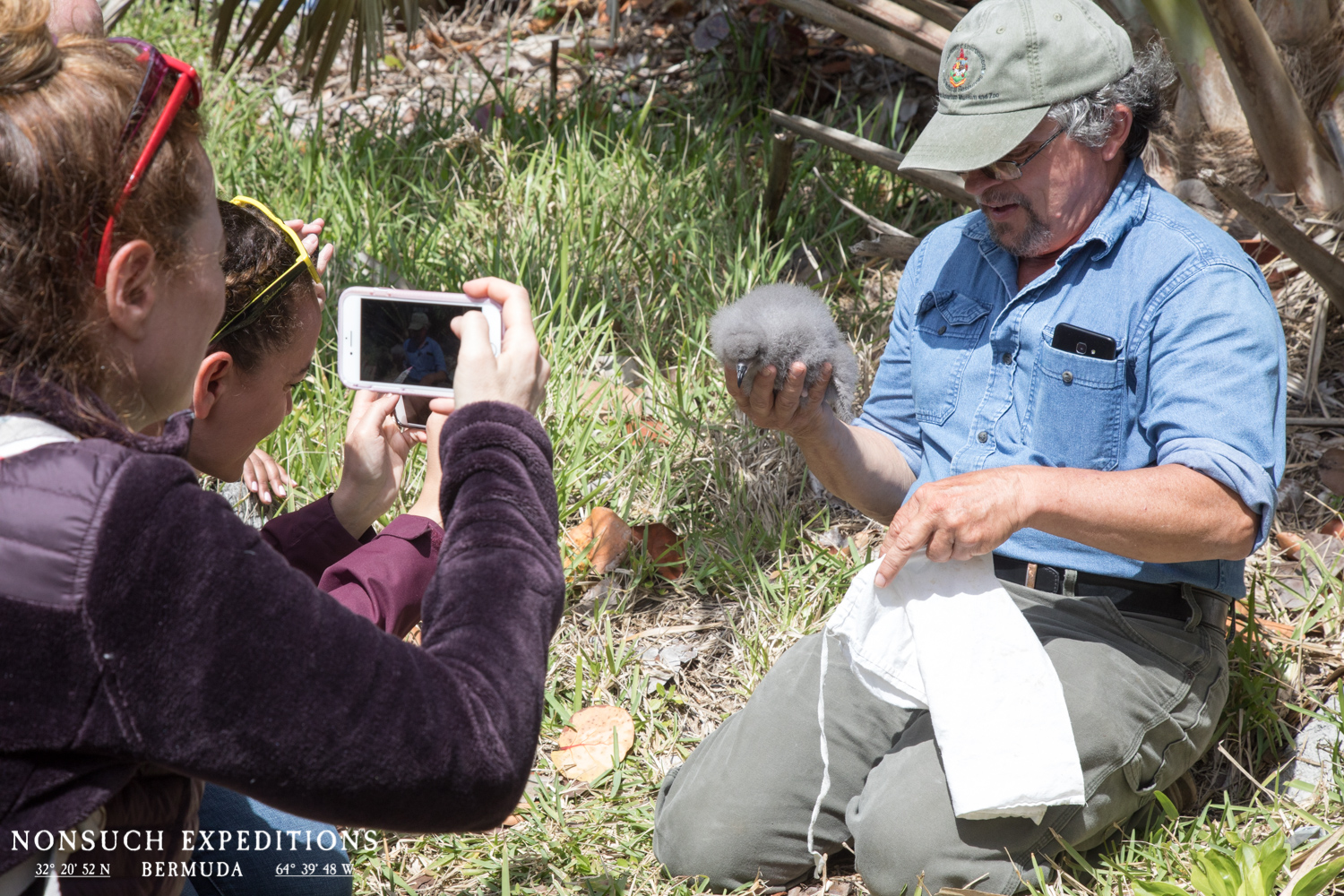
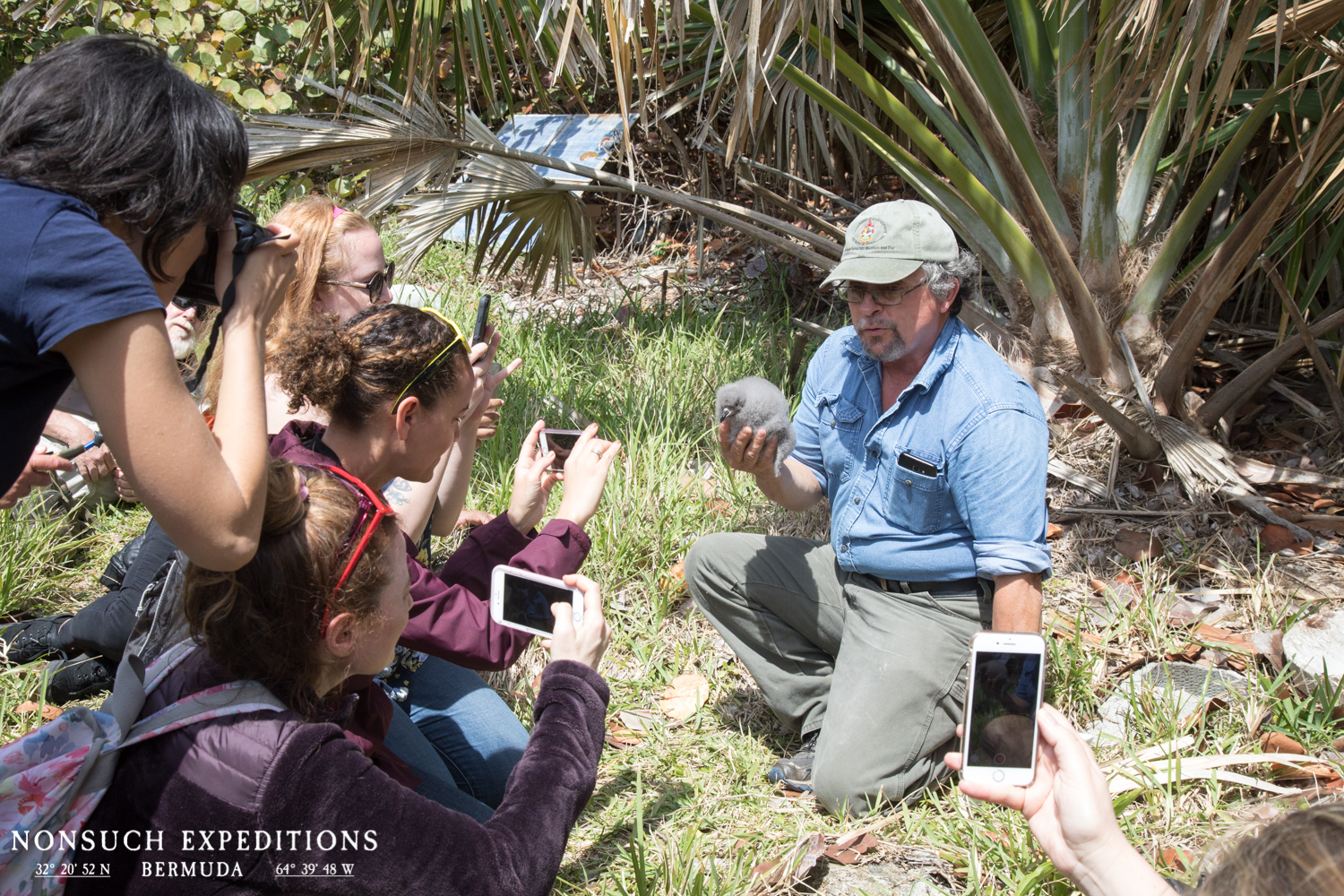

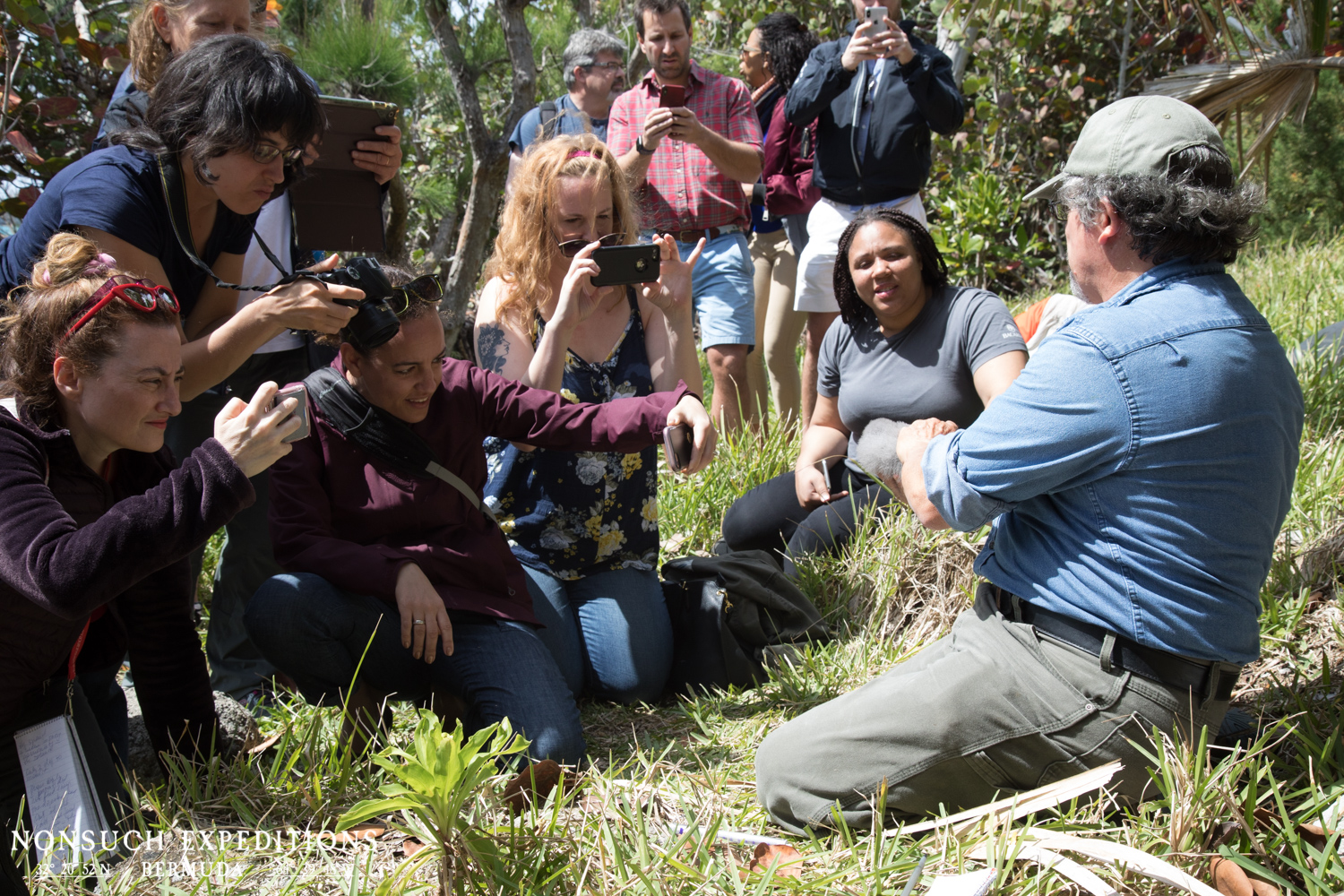
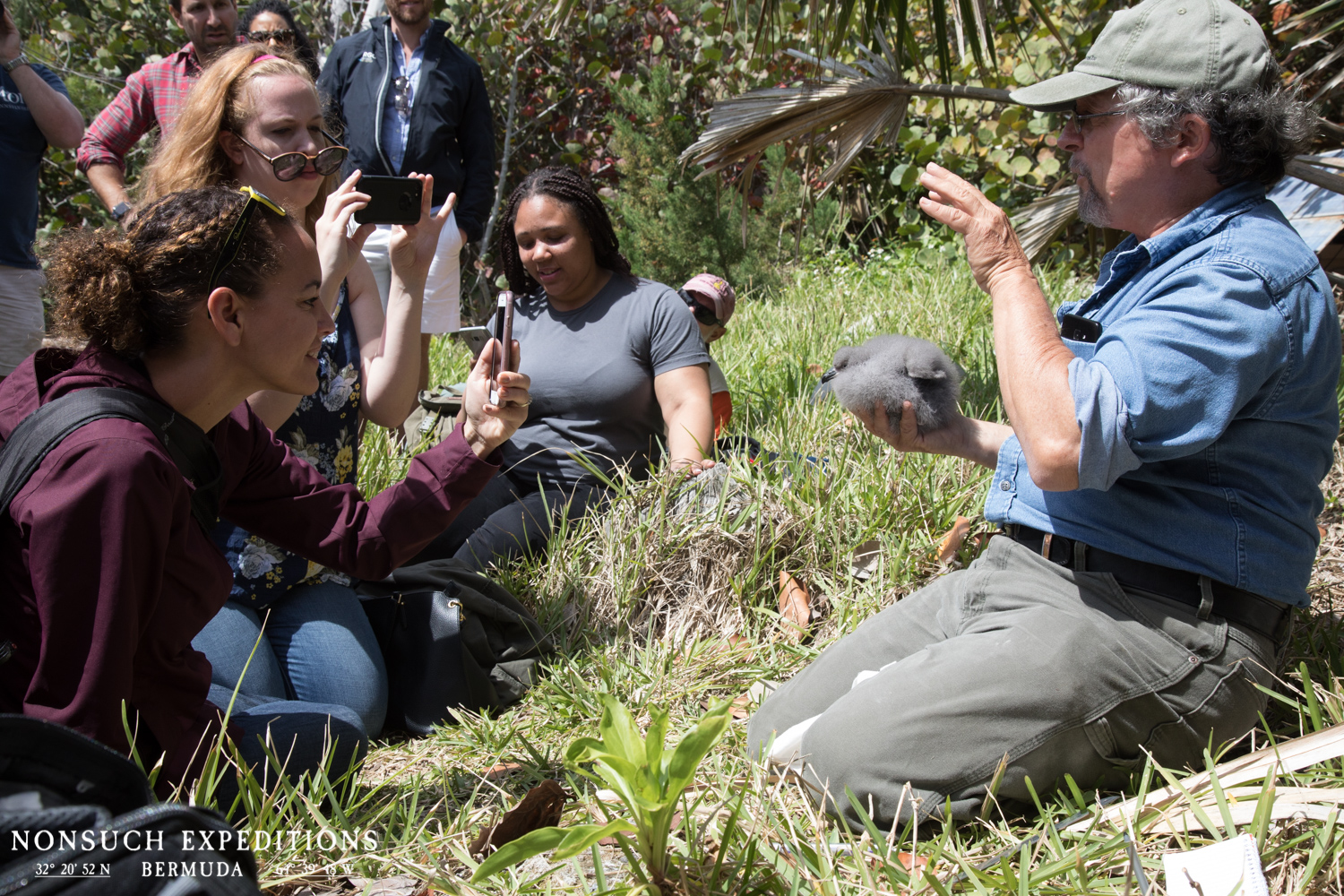
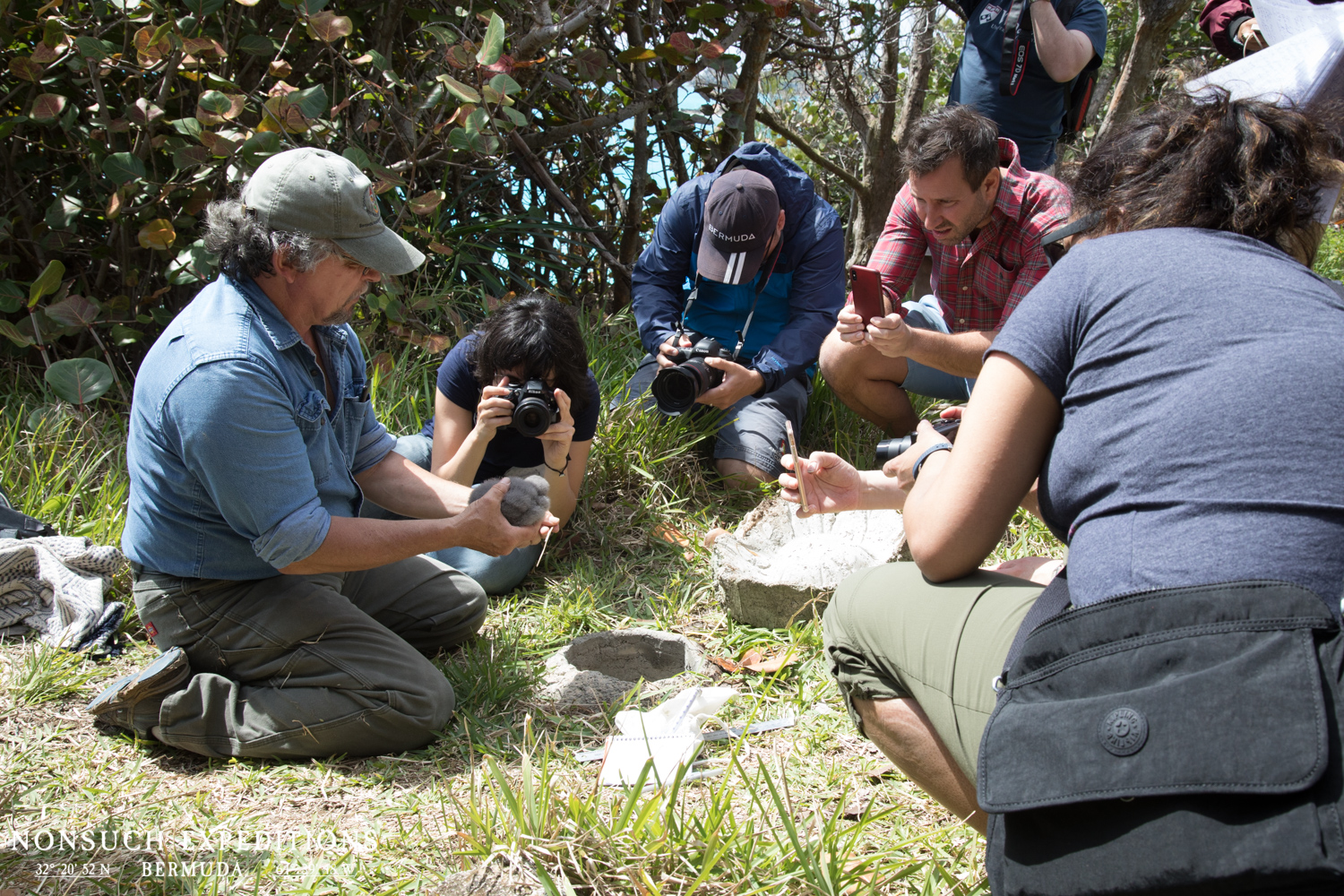

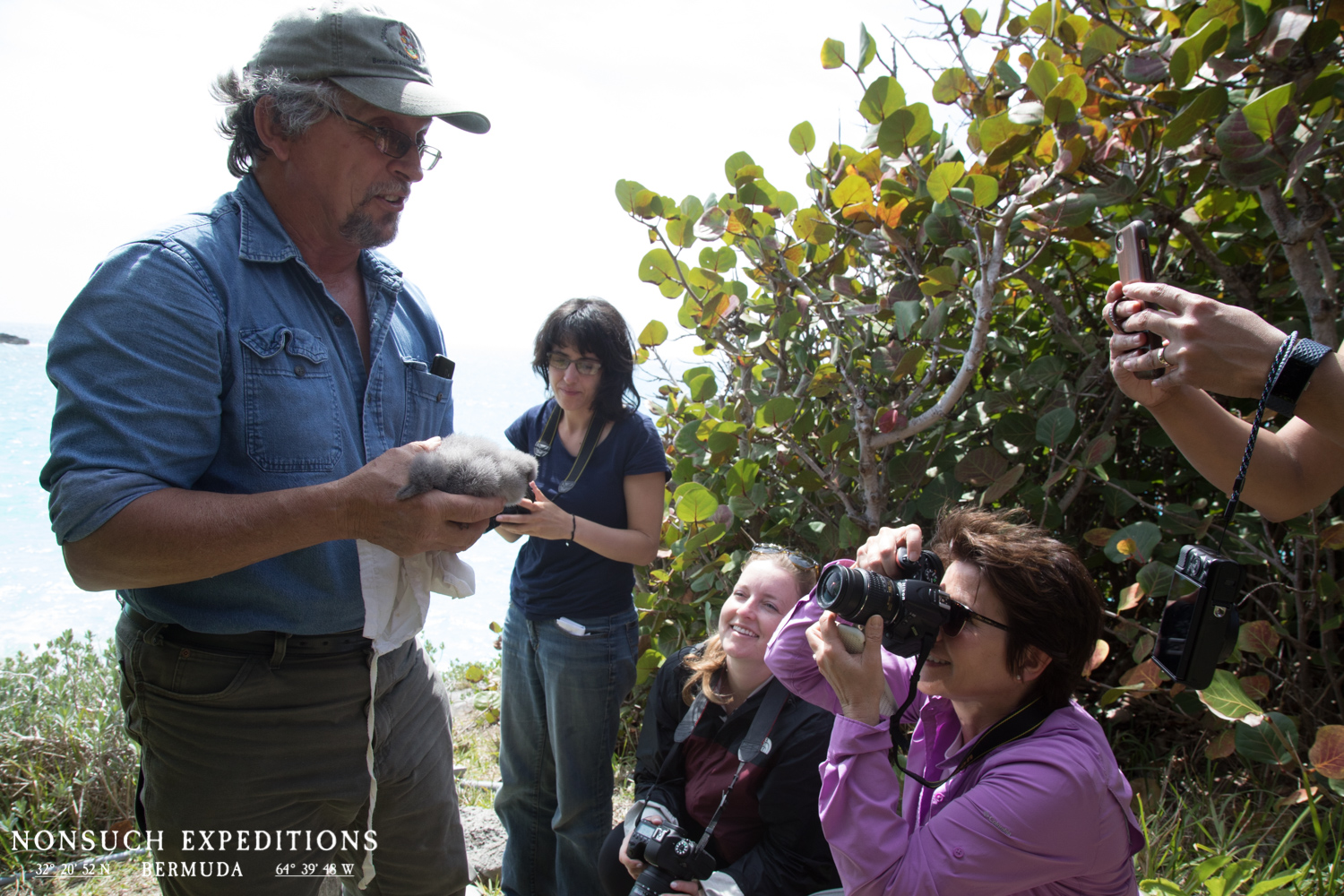
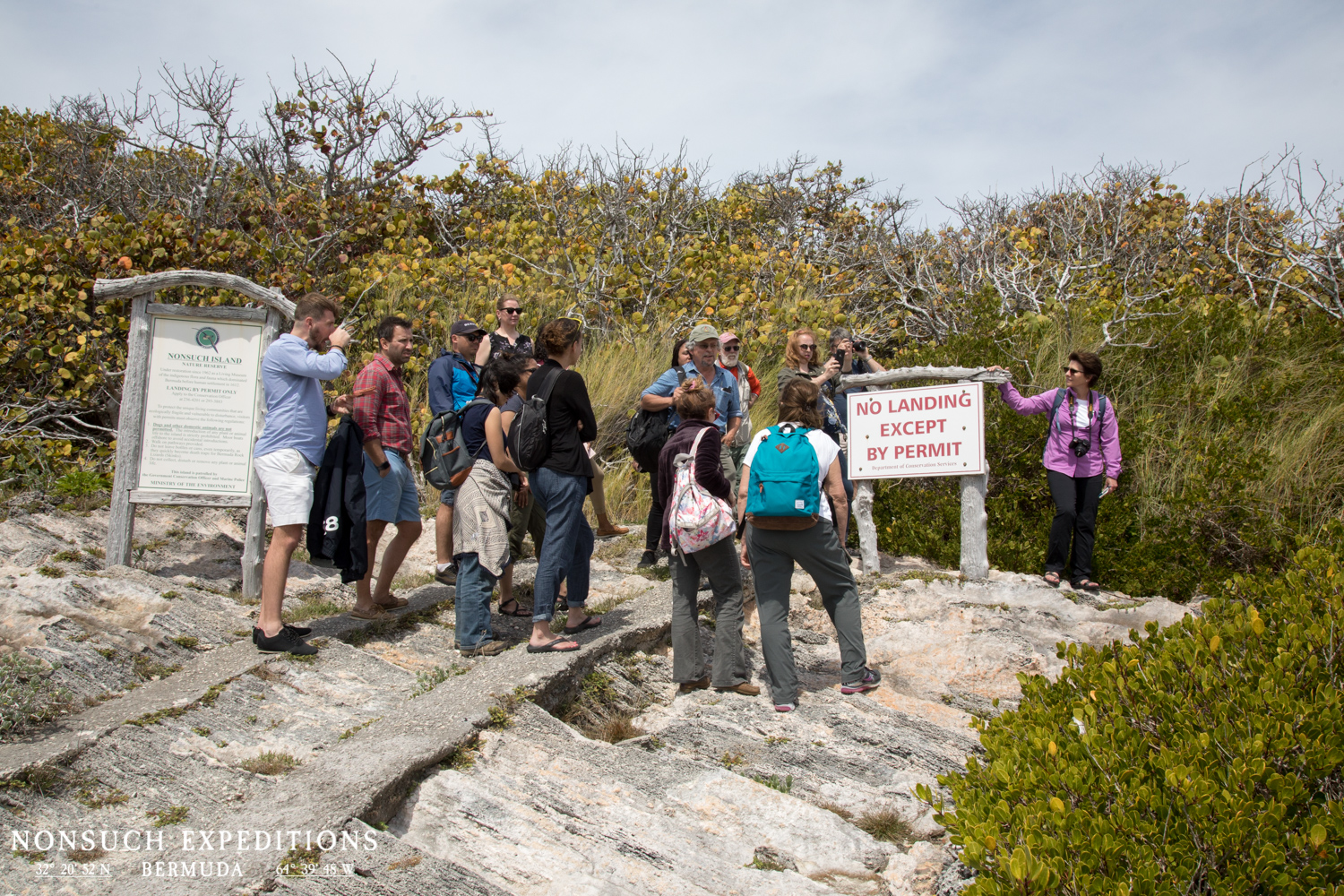

A group of Conservation Travel writers visiting Bermuda with the Bermuda Tourism Authority joined Jeremy Madeiros and the Nonsuch Expeditions Team for a Tour of Nonsuch Island and met the latest chicks from Cahow Colony A.
Jeremy explains how the failure of the CahowCam 1 egg provides a much needed break for the parents that have raised a chick each of the past 5 years.
So far, the 2019 Cahow nesting season looks like it is a fairly successful one, with over 60 chicks now confirmed as having hatched, with the final number waiting for the current high winds and rain to abate so further nest checks can take place on the smaller nesting islets.
On Nonsuch Island, it looks like a total of 12 chicks have now hatched, including the first 2 chicks ever at the new, 2nd translocation colony site. With the CahowCam nests, the recently installed "CahowCam 2" camera recorded the successful hatching of its chick on the night of 9th March. This chick seems to be getting regular feeding visits by the parent birds and is gaining weight steadily.
However, at the "CahowCam1" nest, as the hatching window passed it became clear that the egg had failed and was not going to hatch. This pair has been unusually successful, raising chicks for 5 consecutive years in a row, whereas Cahow pairs are usually only successful every other year or at best 2 years out of 3. Usually, when an egg fails, the parents will faithfully continue to try and incubate it for at least another 2 or 3 weeks, which has been the case with this pair. Typically, once a pair finally accepts that an egg will not hatch, they often will kick the egg out of the nest or, alternatively, will partly or completely bury it with nest material. This is what has happened last night (20/21 March), when the adult brought large amount of additional nest material in, ultimately completely burying the egg. This is the first time we have observed this on the CahowCam, due to the pair being successful every previous year since the camera was installed! This points to the value of these burrow cams, that even when failure inevitably occurs, that we can still gain previously unknown insights and observations that were not possible before. The adults may continue to visit the failed nest on & off until around the beginning of April, then will depart for their mid-Atlantic summer habitat, where they will feed, regain their strength, and prepare for the start of the next breeding season in November.
All the best, Jeremy
Jeremy Madeiros Senior Conservation Officer (Terrestrial) Dept. of Environment and Natural Resource
















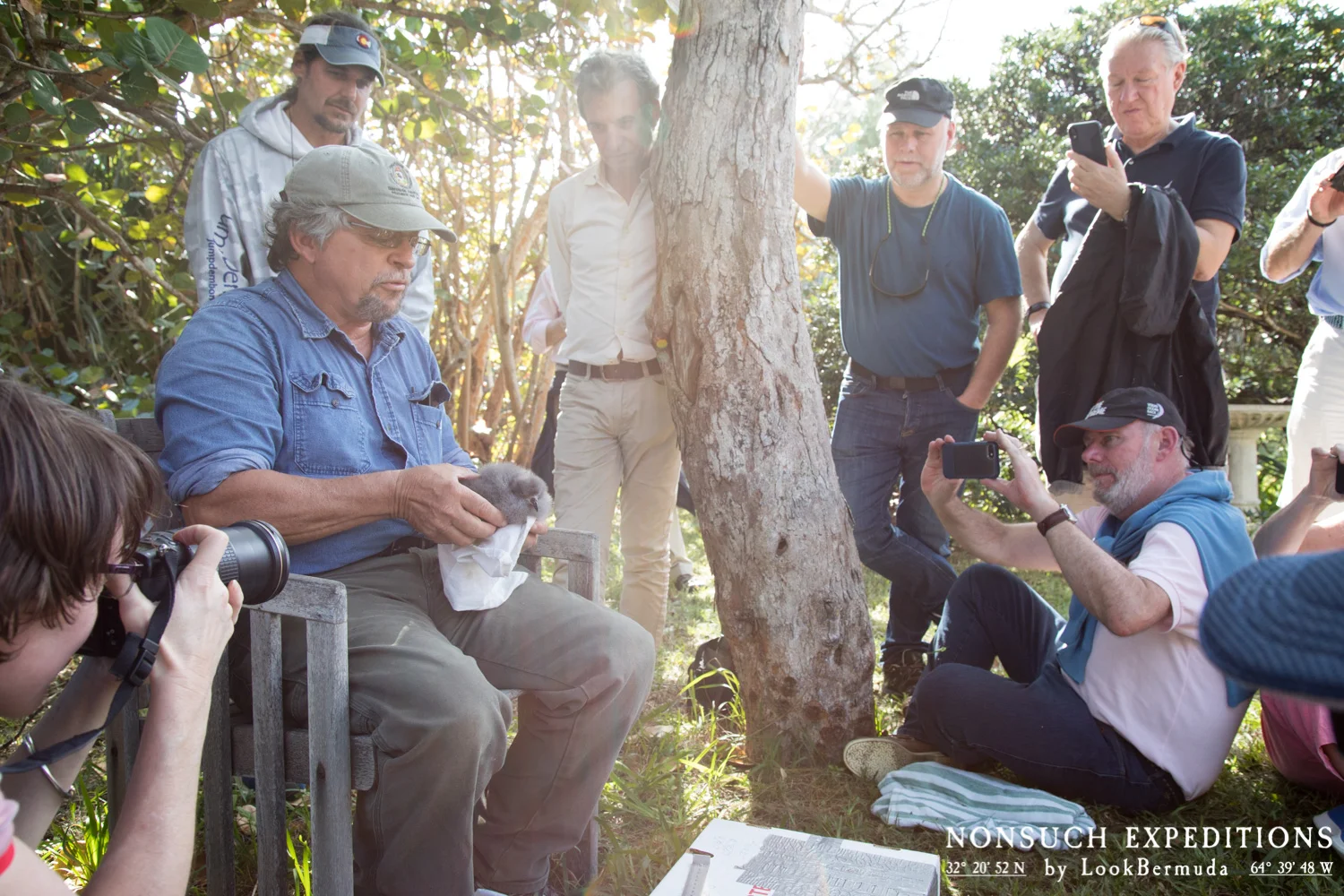










On the final day of the Next Steps for Strengthening Stewardship of the Sargasso Sea workshop held at the Bermuda Institute of Ocean Sciences, thirty of the participants, including representatives from the Sargasso Sea Commission’s Signatories, Commissioners, and partners had the opportunity to take part in an excursion to Nonsuch Island with Nonsuch Expeditions. These participants had the rare opportunity to observe a scheduled nest check for two of the new Cahow chicks, as well as observe some of the species living in Sargassum.
At approximately 10:30pm on Saturday night, viewers from around the world watched as the Cahow egg in Burrow #832 began to hatch. Watch CahowCam LIVE Now
Nonsuch Expeditions Team Leader and CahowCam developer Jean-Pierre Rouja."The first hint that something was going on was a broken egg shell. Then, around 11:30pm, the chick’s head first appeared from under its parent. Progressively, throughout the night, more and more of it was revealed."
Senior Terrestrial Conservation Officer Jeremy Madeiros: “We were very happy to see the chick hatching in the 2ndCahowCam nest, and a bit surprised as I was not really expecting hatching to occur for several days yet. When I returned to my records, I could see the adult had returned during a stormy period in January when I had not been able to visit Nonsuch, so the egg was laid at the beginning of this period, not the end as thought. This brings the number of Cahow chicks so far confirmed as hatching on Nonsuch to 9, with adults in 4 nests still incubating eggs. The total number of chicks confirmed on all nesting islands now is over 45, with more nest checks scheduled over the next week, weather permitting.”
The CahowCam Project is now in its seventh season broadcasting LIVE from Nonsuch Island, and the third season in collaboration with the Cornell Lab of Ornithology (with whom over 15 million minutes of CahowCam video were watched over the past two years).
The new CahowCam 2 had just been installed in Burrow #832 only a few days prior to the hatching. It's one of several that the team is installing this season to give researchers, students, and viewers around the world fascinating insights into the nesting activities of the second rarest seabird on the planet. It is located alongside burrow #831 from which the current CahowCam continues to stream as it has for the past five years. Historically, Burrow #832 hosted the Camera for the first two CahowCam seasons (2013-2014) during which the same pair successfully reared chicks named “Backson” and “Lightning”.
The Minister of Home Affairs the Hon. Walter Roban: "I am so pleased to hear of another successful hatching at Nonsuch Island. I want to give a huge congratulations to the staff of the Department of Environment and Natural Resources who work tirelessly - sacrificing their weekends and evenings - to help bring our national bird back from the brink of extinction. Thank you also to Nonsuch Expeditions for enabling these incredible moments to be captured on camera and shared with a worldwide audience."
"Going forward we plan to be LIVE streaming both cameras in parallel to allow researchers and our followers to observe the similarities and differences in behaviors between the two pairs' nesting seasons," said J-P Rouja. “As we were going LIVE with this new camera during the most sensitive part of the nesting season (egg incubation), it was important to install the camera in the least disruptive way possible. Accordingly, we have custom-built new infrared lights to work with our new HD camera to fit in the pre-existing four-inch PVC pipe that remained in place from the original CahowCam setup in this same nest in 2013/14. This also brings us back to the traditional Top Down view that we used for first few CahowCam seasons, giving us an alternate wider view of the entire nest chamber from above. “
Jeremy Madeiros: “This Season we are working with international researchers to track the Cahow’s foraging expeditions using new nano-gps tags to shed light on where they are finding their food in the Sargasso Sea and beyond. In addition, there is concern that new proposals to carry out oil and gas exploration on the Continental Shelves may present a potential threat to the Cahow and many other seabirds, as previous geolocator tagging indicated that Cahows visit these areas regularly for foraging.… In parallel we are doing blood work to identify contaminants that may be exposed to through their food, all of which will assist with the ongoing management of the species.”
JP Rouja: “We archive each season in HD in its entirety, recording 24/7 for 7 months which we will combine with the maps generated by the Geo tags and the LIVE footage for the STEAM curriculum that we are developing with Cornell. This will be used Internationally in K-12 through University, and adapted locally for public and private schools where it is perfect for localizing and creating cross-curricular lessons that will better engage our students.”
Cornell Lab of Ornithology Bird Cams Project Leader Charles Eldermire: "I continue to be amazed at how close these rare petrels are to the technology and infrastructure that enables us to share their lives with the world. It's really a testimony to both the ongoing efforts of Jeremy and the Bermuda Government as well as the investment from Nonsuch Expeditions that our far-flung audience can now observe two sets of petrels."
David Freestone, Executive Secretary, Sargasso Sea Commission:“The Sargasso Sea Commission is convening a workshop this week in Bermuda and one of the issues being looked at is the connectivity between the Sargasso Sea, Bermuda and the wider Atlantic ocean system. The cahow, is an iconic creature that symbolizes the connectivity between Bermuda and the open ocean - particularly the Sargasso Sea and now this research will provide data to back this up. Its recovery is a great tribute to the dedicated conservation work of Bermudians which is being showcased to the world…”
John W. Fitzpatrick, Director, Cornell Lab of Ornithology: “The Cornell Lab of Ornithology is thrilled to partner with Nonsuch Expeditions in helping share with the world the intimate biology of these extraordinarily rare petrels, and the conservation success story they represent. We join hundreds of thousands of viewers in hoping that this new chick survives to fledging, and eventually returns to breed on Nonsuch Island.”
Meet the 2019 Nonsuch Island Cahow Chicks - Click for closeups -
CahowCam 2 on Nonsuch Island
A second CahowCam has been launched with a projected hatching window of the 10th - 17th of March.
Now in the 7th season broadcasting LIVE from Nonsuch Island, and the 3rd in collaboration with the Cornell Lab of Ornithology (with whom over 15 million minutes of CahowCam video were watched over the past 2 years) our Team has begun installing several new cameras this season giving researchers, students, and viewers around the world alternate views into the nesting activities of the second rarest seabird on the planet.
This new camera is located in burrow #832 right alongside burrow #831 from which the current CahowCam continues to stream as it has for the past 5 years. Historically, this “new” burrow #832 hosted the Cam for the first two CahowCam seasons (2013-2014) during which the same pair successfully reared chicks named “Backson” and “Lightning”. This season the #832 pair are once again incubating what looks to be a viable egg which is projected to hatch between the 10th and 17th of March.
Going forward we plan to be LIVE streaming both cameras in parallel allowing researchers and our followers to observe the similarities and differences in behaviors between the two pairs' nesting seasons.
Charles Eldermire | Cornell Lab of Ornithology Bird Cams Project Leader: "I continue to be amazed at how close these rare petrels are to the technology and infrastructure that enables us to share their lives with the world. It's really a testimony to both the ongoing efforts of Jeremy and the Bermuda government as well as the investment from JP at Nonsuch Expeditions that our far-flung audience gets to now observe two sets of petrels."
Jean-Pierre Rouja | Nonsuch Expeditions Team Leader and CahowCam developer: “As we are going LIVE with this new camera during the most sensitive, egg incubation part of the nesting Season it was important to install the camera in the least disruptive way possible. Accordingly we have custom built new infrared lights to work with our new HD camera to fit in the pre-existing 4 inch PVC pipe that remained in place from the original CahowCam setup in this same nest in 2013/14. This also brings us back to the traditional Top Down view that we used for first few CahowCam seasons, giving a wider view of the entire nest chamber from above.”
Watch both the original CahowCam and CahowCam2 LIVE here now.
As chicks start hatching throughout the Colony, keep watching the CahowCam and NEW CahowCam2 nests LIVE for the opportunity to witness an egg hatching
The egg in the original CahowCam nest is projected to hatch this week and then the egg in the New CahowCam 2 nest is projected to hatch in about 10 days…
